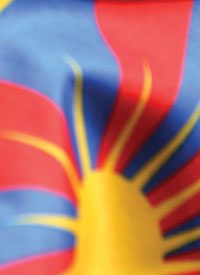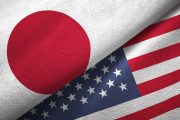
Tibet has a history that dates back to at least the seventh century A.D., with a unique language and culture of its own. Buddhism was established as the state religion in the eighth century. A succession of leaders, referred to by the title "Dalai Lama," constituted both the spiritual and governmental chiefs of Tibet from the 17th century until 1959.
During much of its history, Tibet was under China’s control. However, after the fall of the Qing dynasty, the Dalai Lama proclaimed Tibet an independent nation in 1913. The Republic of China, founded by Sun Yat-sen, never agreed with the proclamation, but used no force against Tibet.
Bondage
However, after the communists completed their seizure of China in 1949, dictator Mao Tse-tung set his sights on the mountain nation. Although his pretext was the debatable assertion that Tibet was really part of China, his goal was conquest for communism. He sent his People’s Liberation Army (PLA) to invade Tibet in October 1950. Americans, preoccupied with the Korean War that had begun that June, barely took notice. The Tibetans showed no desire to be "liberated," but Mao’s troops defeated their poorly equipped army in a matter of days, killing over 5,000 Tibetan soldiers. Those who surrendered were given lectures on socialism, then released.
In May 1951, with Communist China’s gun at its head, Tibet signed a 17-point agreement. Under the arrangement’s terms, Tibet was declared a part of the "motherland," the People’s Republic of China. In turn, China was supposed to allow the Tibetans to retain their religion, culture, and values.
These latter promises proved largely rhetorical, however, and Tibetans suffered terribly under communist rule. By 1962, only 70 of Tibet’s 2,500 monasteries remained. Many monks and nuns were tortured or killed; some were even forced to have sex with each other, in violation of their celibacy vows. And hundreds of thousands of Tibetans died at the hands of the communists — from military actions, executions, and communist-induced famine. Sporadic uprisings increased, but were brutally suppressed.
Tensions reached a climax in March 1959. General Tan Guansan, commandant of Chinese forces in Lhasa — Tibet’s capital — invited the young Dalai Lama to a culture show at Chinese headquarters. He was instructed to come without his bodyguards. It was evident that a plan was afoot to abduct the Dalai Lama, and 300,000 Tibetan citizens surrounded his palace to prevent him from attending the event.
This was the beginning of a major revolt. Lhasa’s population took to the streets, proclaiming Tibet’s independence. Chinese troops moved into place. When artillery shells exploded near his palace on March 17, the Dalai Lama, along with some other officials, escaped, and successfully made their way across the Himalayas to India, which granted them asylum. The Dalai Lama remains there to this day.
"We had definite information," writes the Dalai Lama, "two or three weeks before I left, that the Chinese were fully prepared to attack us. It was only a question of the day and hour." On March 19, open warfare began between the Chinese military and the protestors in Lhasa. The Chinese fired over 800 artillery shells on the civilian population; an estimated 86,000 died. In two days, the revolt was over. The Dalai Lama’s bodyguard regiment was disarmed and machine-gunned. A senior lama, Pagbalha Soinam Gyamco, was killed and dragged by horse before the crowds.
With typical Marxist posturing, Communist China reported that "the garrison units of the PLA in Tibet observe strict discipline, all enjoy the warm support and love of the people of all sections of Tibet and the rebellious conspiracy of a handful of reactionaries had no support from the Tibetan people." This untruthful report ignored the fact that most of Lhasa’s citizens had participated in the revolt.
A Continuing Struggle
Today, China’s heavy hand remains on Tibet. Just owning a copy of Tibet’s national flag can lead to a prison term of seven years. Monks are forced to undergo "re-education" and denounce the Dalai Lama. Those who refuse are often beaten. Gyaltsen Drolkar, a Buddhist nun imprisoned by the Chinese for 12 years, now living in asylum, says, "The whole Tibetan plateau is a prison."
When the Beijing Olympics were approaching, on March 10, 2008 — the 49th anniversary of the Lhasa uprising — 500 monks marched in peaceful protest about five miles from the city. This resulted in numerous arrests, provoking further unrest. China moved tanks in to crush the protestors. According to Tibet’s government-in-exile, over 200 Tibetans were killed, 1,200 injured, and 7,000 arrested. The Chinese expulsion of foreign journalists from Tibet ensured there would be no witnesses.
This March, as the critical 50th anniversary of the Lhasa uprising drew near, China took no risks, and established a massive military and police presence in Tibet to pre-empt any further uprisings. The banning of foreign journalists and tourists from most of Tibet has made the situation difficult to assess.
In a proclamation marking the revolt’s 50th anniversary, the Dalai Lama said, "To work for the just cause of Tibet is the responsibility of every Tibetan, and as long as I live I will uphold this responsibility." It is noteworthy that many of the protestors in Tibet over the past year have been youths who did not see the 1959 revolt. This demonstrates that national pride is very difficult to eliminate. The inability of the communists to destroy Tibet’s religious fervor also shows that deeply held spiritual beliefs are virtually ineradicable.
On March 11, the U.S. House of Representatives, by a vote of 422 to 1, approved a resolution urging China to "cease its repression of the Tibetan people, and to lift immediately the harsh policies imposed upon Tibetans."
However, there are caveats that go with the issue. The "Free Tibet" movement is fashionable among many members of the Hollywood set, such as Richard Gere and Paris Hilton. One reason may be that Buddhism is very compatible with the New Age philosophy popular in Hollywood. Actor Steven Seagal, a major supporter of Tibetan independence, has been recognized as a reincarnated Tibetan Buddhist lama. The brutal persecution of Christians overseas rarely rates the same level of media coverage as the "Free Tibet" movement. Christian missionaries were expelled from Tibet as of 1745, so the country itself does not model religious tolerance.
Interestingly, the sole vote in the U.S. House of Representatives opposing the Tibet resolution came from Ron Paul, the widely respected constitutionalist. Paul’s vote could well be seen as consistent with George Washington’s advice, in his Farewell Address, to avoid "foreign entanglements." Rachel Mills, a spokesperson for Representative Paul, explained: "I don’t think the United States would like it too much if China postured in a similar way on our affairs, and there is really no benefit to these types of actions for us."
James Perloff is the author of The Shadows of Power: The Council on Foreign Relations and the American Decline and Tornado in a Junkyard: The Relentless Myth of Darwinism.
Photo: AP Images



